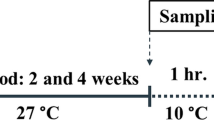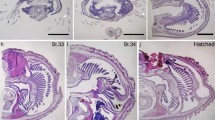Abstract
Fish live in aquatic areas with varying salinity from fresh water to seawater. Gills are one of the most important osmoregulatory organs for maintaining the salt–water balance. In this study, changes in the gills of velifera (Poecilia sphenops) acclimated to 20, 30, 40, and 50 ppt of saline in the laboratory were examined histologically and immunohistochemically. Mucus cells (MCs), proliferating cell nuclear antigen (PCNA), mitochondria-rich cells (MRCs), and heat shock proteins (HSP70) + cells were marked in the gill tissue, which underwent routine histological procedures, and the severity of histological alterations increase with the increase of the salinity. When the gills were examined histologically, it was determined that there was an increase in cells due to hyperplasia, especially in the primary lamellae. A rapid increase in MC and HSP70 + cell numbers was observed in the 20 and 30 ppt groups. Although PCNA + cells were present in each salinity group, they were observed in the salinity group up to 50 ppt. An increase in the number and volume of MRCs was observed with increasing salinity. Based on the histological and immunohistochemical results, it is thought that the cytological and molecular arrangements of cells in gills of sailfin velifera under different levels of salinity are essential for the regulation of ion and salt balance.






Similar content being viewed by others
Data availability
All relevant data are within the paper, and those are available at the corresponding author.
Code availability
Not applicable.
References
Alkan Z, Oğuz AR (2021) Investigation of gill mucus cells of Lake Van fish (Alburnus tarichi) during reproductive migration. Fish Physiol Biochem 47(2):409–419. https://doi.org/10.1007/s10695-020-00921-6
Cabillon NAR, Lazado CC (2019) Mucosal barrier functions of fish under changing environmental conditions. Fishes 4(1):2. https://doi.org/10.3390/fishes4010002
Capps KA, Nico LG, Mendoza-Carranza M, Arévalo-Frías W, Ropicki AJ, Heilpern SA, Rodiles-Hernández R (2011) Salinity tolerance of non-native suckermouth armoured catfish (Loricariidae: Pterygoplichthys) in South-eastern Mexico: implications for invasion and dispersal. Aquat Conserv 21(6):528–540
Chang IC, Lee TH, Yang CH, Wei YY, Chou FI (2001) Morphology and function of gill mitochondria-rich cells in fish acclimated to different environments. Physiol Biochem Zool 74(1):111–119
Cipriano FDS, Luz RK, Lorenzini JPS, Nakayama CL, Neves LDC, Gonçalves-Júnior LP, Miranda-Filho KC (2023) Tolerance to salinity and its effect on development of velifera molly Poecilia velifera (Regan 1914). J Appl Aquac 35(2):380–393
Dawood MA, Noreldin AE, Sewilam H (2021) Long term salinity disrupts the hepatic function, intestinal health, and gills antioxidative status in Nile tilapia stressed with hypoxia. Ecotoxicol Environ Saf 220:112412. https://doi.org/10.1016/j.ecoenv.2021.112412
Dezfuli BS, Giari L, Lui A, Squerzanti S, Castaldelli G, Shinn AP, Manera M, Lorenzoni M (2012) Proliferative cell nuclear antigen (PCNA) expression in the intestine of Salmo trutta trutta naturally infected with an acanthocephalan. Parasit Vectors 5(1):1–8. https://doi.org/10.1186/1756-3305-5-198
Evans TG, Kültz D (2020) The cellular stress response in fish exposed to salinity fluctuations. J Exp Zool A Ecol Integr Physiol 333(6):421–435. https://doi.org/10.1002/jez.2350
Evans DH, Piermarini PM, Choe KP (2005) The multifunctional fish gill: dominant site of gas exchange, osmoregulation, acid-base regulation, and excretion of nitrogenous waste. Physiol Rev 85(1):97–177. https://doi.org/10.1152/physrev.00050.2003
Feder ME, Hofmann GE (1999) Heat-shock proteins, molecular chaperones, and the stress response: evolutionary and ecological physiology. Annu Rev Physiol 61(1):243–282
Formicki K, Kirschbaum F (eds) (2019) The histology of fishes. CRC Press. p 456. https://doi.org/10.1201/9780429113581
Genten F, Terwinghe E, Danguy A (2009) Atlas of Fish Histology. CRC Press
Gibbons TC, McBryan TL, Schulte PM (2018) Interactive effects of salinity and temperature acclimation on gill morphology and gene expression in threespine stickleback. Comp Biochem Physiol Part A Mol Integr Physiol 221:55–62. https://doi.org/10.1016/j.cbpa.2018.03.013
Gonzalez RJ (2012) The physiology of hyper-salinity tolerance in teleost fish: a review. J Comp Physiol B 182(3):321–329. https://doi.org/10.1007/s00360-011-0624-9
Gonzalez RJ, Cooper J, Head D (2005) Physiological responses to hyper-saline waters in sailfin mollies (Poecilia latipinna). Comp Biochem Physiol Part A Mol Integr Physiol 142(4):397–403. https://doi.org/10.1016/j.cbpa.2005.08.008
Haney DC (1999) Osmoregulation in the sheepshead minnow, Cyprinodon variegatus: influence of a fluctuating salinity regime. Estuarie 22(4):1071–1077
Hassan M, Zakariah MI, Wahab W, Muhammad SD, Idris N, Jasmani S (2013) Histopathological and behavioral changes in Oreochromis sp. after exposure to different salinities. J Fish Livest Prod 1:2. https://doi.org/10.4172/2332-2608.1000103
Hermenean A, Gheorghiu G, Stan MS, Herman H, Onita B, Ardelean DP, Ardelean A, Braun M, Zsuga M, Kéki S, Costache M, Dinischiotu A (2017) Biochemical, histopathological and molecular responses in gills of Leuciscus cephalus exposed to metals. Arch Environ Contam Toxicol 73(4):607–618. https://doi.org/10.1007/s00244-017-0450-5
Iwama GK, Thomas PT, Forsyth RB, Vijayan MM (1998) Heat shock protein expression in fish. Rev Fish Biol Fish 8(1):35–56. https://doi.org/10.1023/A:1008812500650
Laurent P, Hebibi N (1989) Gill morphometry and fish osmoregulation. Can J Zool 67:3055–3063. https://doi.org/10.1139/z89-429
Lee TH, Hwang PP, Lin HC, Huang FL (1996) Mitochondria-rich cells in the branchial epithelium of the teleost, Oreochromis mossambicus, acclimated to various hypotonic environments. Fish Physiol Biochem 15(6):513–523. https://doi.org/10.1007/BF01874924
Lee TH, Hwang PP, Shieh YE, Lin CH (2000) The relationship between ‘deep-hole’ mitochondria-rich cells and salinity adaptation in the euryhaline teleost. Oreochromis Mossambicus Fish Physiol Biochem 23(2):133–140. https://doi.org/10.1023/A:1007818631917
Martins YS, Melo RMC, Campos-Junior PHA, Santos JCE, Luz RK, Rizzo E, Bazzoli N (2014) Salinity and temperature variations reflecting on cellular PCNA, IGF-I and II expressions, body growth and muscle cellularity of a freshwater fish larvae. Gen Comp Endocrinol 202:50–58. https://doi.org/10.1016/j.ygcen.2014.03.047
Mohamed NA, Saad MF, Shukry M, El-Keredy AM, Nasif O, Van Doan H, Dawood MA (2021) Physiological and ion changes of Nile tilapia (Oreochromis niloticus) under the effect of salinity stress. Aquac Rep 19:100567. https://doi.org/10.1016/j.aqrep.2020.100567
Monteiro SM, dos Santos NM, Calejo M, Fontainhas-Fernandes A, Sousa M (2009) Copper toxicity in gills of the teleost fish, Oreochromis niloticus: effects in apoptosis induction and cell proliferation. Aquat Toxicol 94(3):219–228. https://doi.org/10.1016/j.aquatox.2009.07.008
Morgan JD, Iwama GK (1998) Salinity effects on oxygen consumption, gill Na+, K+-ATPase and ion regulation in juvenile coho salmon. J Fish Biol 53(5):1110–1119. https://doi.org/10.1111/j.1095-8649.1998.tb00467.x
Nilsson GE, Dymowska A, Stecyk JA (2012) New insights into the plasticity of gill structure. Respir Physiol Neurobiol 184(3):214–222. https://doi.org/10.1016/j.resp.2012.07.012
Nordlie FG (1987) Salinity tolerance and osmotic regulation in the diamond killifish, Adinia xenica. Environ Biol Fishes 20:229–232
Nordlie FG, Haney DC, Walsh SJ (1992) Comparisons of salinity tolerance and osmotic regulatory capabilities in populations of sailfin molly (Poecilia latipinna) from brackish and fresh waters. Copeia 1992:741–746
Oğuz AR (2013) Environmental regulation of mitochondria-rich cells in Chalcalburnus tarichi (Pallas, 1811) during reproductive migration. J Membr Biol 246(3):183–188. https://doi.org/10.1007/s00232-012-9518-3
Olukolajo SO, Omolara LAA (2013) Salinity tolerance of grey mullet, Mugil cephalus (Linnaeus) fry in the laboratory. J Fish Sci 7(4):292–296. https://doi.org/10.3153/jfscom.2013031
Ortego LS, Hawkins WE, Walker WW, Krol RM, Benson WH (1994) Detection of proliferating cell nuclear antigen in tissues of three small fish species. Biotech Histochem 69(6):317–323. https://doi.org/10.3109/10520299409106312
Peng G, Zhao W, Shi Z, Chen H, Liu Y, Wei J, Gao F (2016) Cloning HSP70 and HSP90 genes of kaluga (Huso dauricus) and the effects of temperature and salinity stress on their gene expression. Cell Stress Chaperones 21(2):349–359. https://doi.org/10.1007/s12192-015-0665-1
Perry SF, Wood CM (1985) Kinetics of brachial calcium uptake in the rainbow trout: effects of acclimation to various external calcium levels. J Exp Biol 116:411–433. https://doi.org/10.1242/jeb.116.1.411
Rajeshkumar S, Mini J, Munuswamy N (2013) Effects of heavy metals on antioxidants and expression of HSP70 in different tissues of Milk fish (Chanos chanos) of Kaattuppalli Island, Chennai, India. Ecotoxicol Environ Saf 98:8–18. https://doi.org/10.1016/j.ecoenv.2013.07.029
Reverter M, Tapissier-Bontemps N, Lecchini D, Banaigs B, Sasal P (2018) Biological and ecological roles of external fish mucus: a review. Fishes 3(4):41. https://doi.org/10.3390/fishes3040041
Roberts SD, Powell MD (2003) Comparative ionic flux and gill mucous cell histochemistry: effects of salinity and disease status in Atlantic salmon (Salmo salar L.). Comp Biochem Physiol Part A Mol Integr Physiol 134(3):525–537. https://doi.org/10.1016/S1095-6433(02)00327-6
Sales CF, Dos Santos KPE, Rizzo E, Rizzo E, de Azambuja Ribeiro RIM, Dos Santos HB, Thomé RG (2017) Proliferation, survival and cell death in fish gills remodeling: from injury to recovery. Fish Shellfish Immunol 68:10–18. https://doi.org/10.1016/j.fsi.2017.07.001
Shui C, Shi Y, Hua X, Zhang Z, Zhang H, Lu G, Xie Y (2018) Serum osmolality and ions, and gill Na+/K+-ATPase of spottedtail goby Synechogobius ommaturus (R.) in response to acute salinity changes. Aquac Fish 3(2):79–83. https://doi.org/10.1016/j.aaf.2018.03.002
Sollid J, De Angelis P, Gundersen K, Nilsson GE (2003) Hypoxia induces adaptive and reversible gross morphological changes in crucian carp gills. J Exp Biol 206(20):3667–3673. https://doi.org/10.1242/jeb.00594
Takahashi H, Sakamoto T, Narita K (2006) Cell proliferation and apoptosis in the anterior intestine of an amphibious, euryhaline mudskipper (Periophthalmus modestus). J Comp Physiol B 176(5):463–468. https://doi.org/10.1007/s00360-006-0067-x
Takashima F, Hibiya T (1995) An atlas of fish histology. In: Normal and pathological features, 2nd edn. Kondansha LTD, Tokyo (JP)
Tang CH, Lee TH (2013) Freshwater acclimation induces stress responses and expression of branchial Na+/K+‐ATPase and proliferating cell nuclear antigen in Takifugu niphobles. J Exp Zool 319(7):409–421. https://doi.org/10.1002/jez.1804
Thomas D, Rekha MU, Angel JRJ, Sreekanth GB, Thiagarajan G, Subburaj R, Kailasam M, Vijayan KK (2021) Effects of salinity amendments on the embryonic and larval development of a tropical brackishwater ornamental silver moony fish, Monodactylus argenteus (Linnaeus, 1758). Aquaculture 544:737073. https://doi.org/10.1016/j.aquaculture.2021.737073
Tine M, Bonhomme F, McKenzie DJ, Durand JD (2010) Differential expression of the heat shock protein Hsp70 in natural populations of the tilapia, Sarotherodon melanotheron, acclimatised to a range of environmental salinities. BMC Ecol 10(1):1–8. https://doi.org/10.1186/1472-6785-10-11
Wilson JM, Laurent P (2002) Fish gill morphology: inside out. J Exp Zool 293(3):192. https://doi.org/10.1002/jez.10124
Yang WK, Hseu JR, Tang CH, Chung MJ, Wu SM, Lee TH (2009) Na+/K+-ATPase expression in gills of the euryhaline sailfin molly, Poecilia latipinna, is altered in response to salinity challenge. J Exp Mar Biol Ecol 375(1–2):41–50. https://doi.org/10.1016/j.jembe.2009.05.004
Zhou Z, Hu F, Li W, Yang X, Hallerman E, Huang Z (2021) Effects of salinity on growth, hematological parameters, gill microstructure and transcriptome of fat greenling Hexagrammos otakii. Aquaculture 531:735945. https://doi.org/10.1016/j.aquaculture.2020.735945
Acknowledgements
The primary antibodies was purchased from the Developmental Studies Hybridoma Bank (DSHB) maintained by the Department of Pharmacology and Molecular Sciences, Johns Hopkins University School of Medicine, Baltimore, MD, and the Department of Biological Sciences, University of Iowa, Iowa City, IA, NICHD, USA.
Funding
This research was supported by the Van Yüzüncü Yıl University, Scientific Research Projects Department (FBA-2021–9339).
Author information
Authors and Affiliations
Contributions
ARO, FS, and AS conceived the study and designed the experiments. ZA, BEA, and AS carried out the histology analyzed the data. ARO and EKO wrote and revised the manuscript. All authors read and approved the final manuscript.
Corresponding author
Ethics declarations
Ethics approval
All of the animal experimental procedures were performed in accordance with the animal study protocols approved by the Animal Researchers Local Ethic Committee of Van Yüzüncü Yıl University (protocol no: 2020/11–20).
Consent to participate
Not applicable.
Consent for publication
Not applicable.
Competing interests
The authors declare no competing interests.
Additional information
Handling Editor: Brian Austin
Publisher's Note
Springer Nature remains neutral with regard to jurisdictional claims in published maps and institutional affiliations.
Rights and permissions
Springer Nature or its licensor (e.g. a society or other partner) holds exclusive rights to this article under a publishing agreement with the author(s) or other rightsholder(s); author self-archiving of the accepted manuscript version of this article is solely governed by the terms of such publishing agreement and applicable law.
About this article
Cite this article
Oguz, A.R., Sepil, A., Alkan, Z. et al. Effects of salinity on gill histology in sailfin velifera (Poecilia velifera). Aquacult Int (2023). https://doi.org/10.1007/s10499-023-01286-2
Received:
Accepted:
Published:
DOI: https://doi.org/10.1007/s10499-023-01286-2




